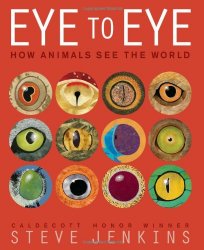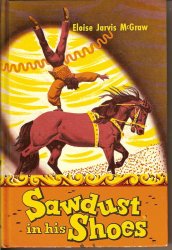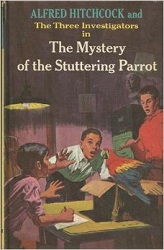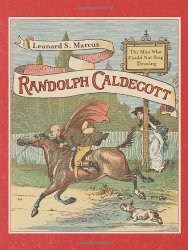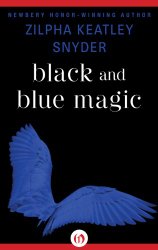Review of Eye to Eye, by Steve Jenkins
How Animals See the World
by Steve Jenkins
Houghton Mifflin Harcourt, Boston, 2014. 36 pages.
Starred Review
Steve Jenkins does it again! He’s the one who can make incredibly detailed animal art using cut paper collage. His art looks like photographs and has amazing levels of detail. When coupled with fascinating facts about animals, his books are exceptional.
Eye to Eye looks at four kinds of animal eyes: eyespots, a simple cluster of light-sensitive cells; pinhole eyes, which can form dim but detailed images; compound eyes with hundreds or thousands of individual facets; and camera eyes, found in all birds, amphibians, reptiles, and mammals, emplying a lens to focus light on the sensitive surface of a retina.
Then he’s got examples of the different types of eyes and all sorts of strange and unusual eyes. We’ve got the biggest eyes in the world (on a colossal squid), eyes bigger than the animal’s brain (on a tarsier), the most highly developed eyes (on a mantis shrimp), eyes that look in two directions (on the brownsnout spookfish), an animal with a third eye on the top of its head (the tuatara), and a creature with as many as 111 eyeballs (the Atlantic bay scallop), among others.
I found some of the creatures a bit disgusting, but I’m guessing that will make certain kids enjoy the book all the more. I learned a lot about eyes reading this book. Another treasure trove of information paired with mind-boggling artwork from Steve Jenkins.
Find this review on Sonderbooks at: www.sonderbooks.com/Nonfiction/eye_to_eye.html
Disclosure: I am an Amazon Affiliate, and will earn a small percentage if you order a book on Amazon after clicking through from my site.
Source: This review is based on a library book from Fairfax County Public Library.
Disclaimer: I am a professional librarian, but I maintain my website and blogs on my own time. The views expressed are solely my own, and in no way represent the official views of my employer or of any committee or group of which I am part.
